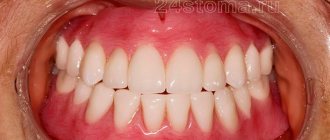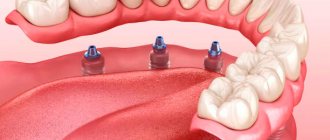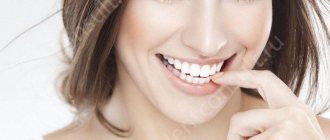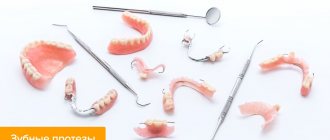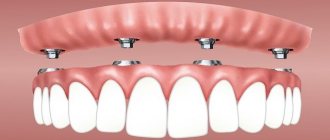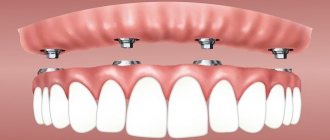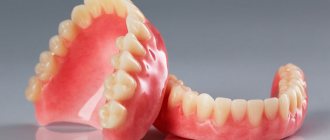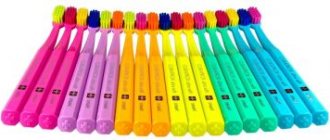From this article you will learn:
- what material are removable dentures made of?
- what types of dentures are there?
- What is the difference between dentures on implants and other removable dentures?
- conditionally removable dentures,
- how to choose the best modern and reliable prostheses,
- how to care for removable dentures,
- Prices for removable dentures in 2021.
About removable dentures
Removable dentures are a type of prosthetics that is carried out when teeth are partially or completely lost. Their feature is the ability to remove the denture (with the exception of some models). They are quite easy to care for. However, removable dentures require careful cleaning and oral hygiene. The advantages of this type of prosthetics:
- high aesthetic indicators;
- uniform load when chewing and, as a result, prevention of bone atrophy;
- individual production for each client;
- easy to care for;
- affordable price;
- quickly installed;
- short period of adaptation.
Today there are a large number of types of prostheses and materials from which these structures are made.
What material is it made from?
The most important characteristics of removable structures, such as secure fixation, wearing comfort and aesthetics, are determined by the materials from which these structures are made.
Plastic
Acrylic plastic is used to make plastic dentures. This option can be used for both complete and partial edentia.
The prosthesis is secured using the “suction effect”. The patient bites down on the denture, excess air comes out of it, and a tight fit to the gum is ensured.
Acrylic
The most popular and affordable dentures are acrylic. Used to restore partially lost teeth.
Pros:
- low cost;
- ease of manufacture and operation;
- good aesthetics - acrylic does not change its properties over time, and is not stained by coffee, tea or cigarettes.
Reviews of acrylic dentures are generally good, except for the possibility of allergies, which is why some patients remove them at night.
The photo shows an acrylic prosthesis
Nylon
Soft dentures are made from elastic nylon. They can be used for both partial and complete absence of teeth.
The positive aspects of nylon prostheses are:
- good level of elasticity;
- they are thinner and lighter compared to other materials;
- high flexibility.
These properties increase wearing comfort. However, this material has more negative aspects than positive ones. Firstly, the healing of the structure: due to the soft elastic nylon, the gums are greatly deformed, so bone resorption may even occur. Secondly, chewing food is often accompanied by pain. Finally, nylon dentures have to be adjusted frequently.
The photo shows a nylon prosthesis
Аcryfree
Acri-free - modern nylon prostheses. This material was first developed by an Israeli company. They occupy an intermediate position between plastic and nylon structures, incorporating their best qualities. Such structures are made from advanced acrylic plastic. They have a slightly greater degree of flexibility than acrylic ones.
Among the advantages they note:
- high aesthetic properties;
- wearing comfort;
- almost invisible thanks to the translucent material.
The photo shows an AcryFree nylon prosthesis
Spofadent
A new version of dentures, which includes three-layer plastic, which gives Spofadent dentures high strength. The material shows high aesthetic properties: it can be easily painted in various shades of pink and white. Dentures made from Spofadent are practically not exposed to chemicals contained in soda, drinks and food. Like Acryfree, this material is translucent, so it is excellent for prosthetics of front teeth.
Ivobase
It is an organic thermoplastic material, the chemical name of which is polymethyl methacrylate. The manufacturing technology of this material itself makes it possible to reduce allergic reactions and eliminate errors when installing dentures (overbite or excessive shrinkage).
Moreover, structures made from Ivobase have increased strength and low porosity, so the material is not stained by pigments contained in food and is slightly susceptible to bacterial attack. Such prostheses have high biocompatibility, quality and wearing comfort.
Vertex
Vertex is a modern thermoplastic material that is manufactured without the use of monomers, which ensures the absence of allergies, burning and itching when worn. Patients do not experience a feeling of dryness, articulation and taste perception are not impaired when using prostheses from Vertex. This material is stronger than other plastic structures, so manufacturers can make the base as thin as possible. You can choose shades of white and pink for each specific occasion. The material has good properties and is therefore suitable for full and partial prosthetics.
The photo shows the Vertex prosthesis
Deflex
The material comes from Argentina. It contains modern innovative thermoplastic polyamide. The base of such dentures is made completely transparent, and if desired, you can give it a pink tint. Such dentures are more flexible and durable than acrylic structures. They are recommended for police officers, firefighters, boxing athletes and other people with traumatic professions. However, this material has several disadvantages:
- ability to absorb odors;
- inability to repair the prosthesis.
Deflex is recommended for use only for partial dentures. However, if other teeth are lost, the entire prosthesis will have to be redone.
The photo shows the Deflex prosthesis
Metal alloys in prosthetics
Today, metal is widely used in dentistry. It is used to produce structural frames, clasp devices, and solid orthopedic products without ceramic coating. What alloys are most often used?
- Compound of chromium with cobalt.
- Alloy of chromium and nickel.
- Compounds containing gold with platinum, palladium.
Such materials for dental prosthetics function perfectly. True, they are not suitable for every patient. Steel causes allergies in some clients, and taste sensations often change. Noble compounds do not cause harm to the body. Nowadays, equipment is used that casts devices with a high degree of accuracy. This makes the fit perfect. It is possible to manufacture extended structures.
A worthy competitor is zirconium. Crowns are created using a laser, which ensures maximum precision. Such designs look natural.
Types of removable dentures
Butterfly
This type of prosthesis is fixed on the so-called clasps - curved metal plates that are attached to neighboring teeth. The prosthesis was named so because the clasps look like the wings of a butterfly in flight. With this type of prosthesis you can replace one or more teeth. Before installing such a prosthesis, it is necessary to maintain the bite and prevent bone tissue atrophy in the area of the lost tooth. The effectiveness of prosthetics depends on speed: the less time passes between the loss of a tooth and the manufacture and installation of a prosthesis, the better it will be for the oral cavity.
The photo shows a removable denture “Butterfly”
Silicone dentures
Silicone dentures allow you to restore chewing function even after the loss of one or several teeth.
They differ:
- high strength;
- convenience and comfort;
- low adaptation period;
- long shelf life (up to 5 years);
- increased strength;
- high degree of fixation;
- food coloring resistant.
Partial removable dentures
Partial dentures are used when several teeth are lost in a row. Typically, such prostheses are installed if implants or a bridge are contraindicated for the patient. Metal hooks secure the denture to adjacent teeth. There are four types of such prostheses
- lamellar;
- removable rows;
- immediate prosthesis;
- clasp
The photo shows a partially removable denture
Their comparative characteristics are given in Table 1.
Table 1. Pros and cons of partial dentures, indications
| Type of partial dentures | pros | Minuses | Indications for installation |
| Lamellar | Affordable price | Short service life (up to 4 years) | Partial dentures (for loss of 2-3 teeth) |
| Removable rows |
|
| Unilateral tooth loss |
| Immediate prosthesis |
|
| Temporary replacement of a lost tooth or service life up to 3 years maximum, after which it will have to be replaced |
| Clasp |
|
| The best option for partially edentulous patients |
In case of complete absence of teeth, prosthetics of the upper and lower jaws are performed. The “suction effect” is used. There are two possible scenarios:
- Removable dentures supported by an implant. Implants improve fixation, taste and diction. However, food and bacteria can accumulate between the gum area and the denture.
The photo shows a removable denture on implants
- Fixed structures. An excellent option for complete absence of teeth (sometimes dentists recommend fixed dentures for partially edentulous patients). However, only a dentist can remove and install them.
Contraindications to the installation of nylon prostheses
In the case of a complex clinical situation, when the conditions for prosthetics are not ideal - large gum atrophy, or low teeth, soft dental prostheses may not provide the ideal. In such cases, it is better to use traditional plastic prostheses:
- With short teeth, the fixation of a soft prosthesis may not be sufficient.
- A complete nylon denture is irrational in cases of severe gum atrophy. Its retention on the jaw may be far from ideal. In this case, a prosthesis made of good plastic is optimal.
- When there are one or two imperfect and mobile teeth left on the jaw, any prosthesis will not only be kept from being suctioned, but will also be fixed by them. This will definitely improve the fixation. Therefore, if there is even one tooth left on the jaw, do not rush to get rid of it - it will still be useful.
If it is subsequently removed, the traditional prosthesis can be quite easily repaired and can continue to be used.
The soft one will have to be completely redone. In general, nylon teeth are a convenient and rational option for dental restoration. The only thing is that you need to use it according to indications, and not try to use it in all situations. When a plastic prosthesis will be more rational.
Summary: indications for flexible prostheses
- Nylon dentures do not break, so they are best used in cases where breakage is very likely.
- It is rational to use a soft prosthesis in situations where it is impossible to place conventional metal clasps or they significantly worsen the aesthetics.
- If you have a strong gag reflex, an elastic denture with an open sky will not cause problems.
- In the presence of the last tooth - to restore chewing teeth without processing them.
- As a temporary prosthesis.
Service life
Like any
removable structures, a flexible prosthesis meets all the requirements for it for 3-4 years. After which it must be adjusted or redone.
Why is this necessary? Over time, inevitable atrophy of the gums and bone occurs. Both with and without a prosthesis. It occurs unevenly on the jaw. Then the prosthesis does not rest on the entire gum, but only on part of it. Causing even greater atrophy and deterioration of fixation.
These changes occur very slowly and gradually. Therefore, many patients do not notice them. And they have been using dentures for 10 and 15 years.
A regular denture can be easily relined. The nylon one will have to be remade again.
Corrections for nylon dentures are carried out in the same way as for other removable prosthetics. Usually less often.
Dentures on implants
Dentures on implants differ from other removable dentures, since implants are implanted into the gums - the future support of the crown. This option is used in cases of complete edentia, when it is necessary to securely secure the prosthesis in the oral cavity. The procedures are carried out as follows:
- 4 implants are implanted into each gum. This is the optimal number, since with 2 implants in one gum the prosthesis can move, and when installing more than 6 pieces, peri-implantitis (or inflammation around the implant) may develop. You will have to treat the inflamed areas; moreover, inflammation in the oral cavity can cause serious complications.
- Two-piece retainers secure the removable denture. They cling to the prosthesis and seem to snap onto the implants. Fastenings can be push-button or beam.
Advantages of dentures on implants:
- a uniform load on the alveolar ridge of the jaw is maintained;
- the design prevents bone destruction;
- long service life (up to 10 years);
- restoration of aesthetic and chewing function, no effect on speech function;
- high degree of fixation.
The disadvantages include:
- high cost
- long installation process (this is due to the fact that the installation of implants is accompanied by a long period of engraftment - this process takes up to 6 months);
- surgical intervention.
Main Difference
Modern dentistry offers various dentures, but, as a rule, they differ from each other only in the number of artificial teeth, aesthetic appearance, method of fastening and the material from which they are made. In addition, structures can be removable or non-removable.
As for non-removable products, they are much more expensive. The patient will also need to pay for installation, although it is inexpensive and sometimes included in the price. But a simple removable one will cost much less. But it is less convenient and reliable, especially if the prosthetic is used by an elderly person whose palate is severely deformed, and the structure will not fit so tightly to the soft tissues.
In addition, any, even the best dentures must be replaced after some time or sent to the laboratory for relining. This is due to the fact that with long-term use, the relief of the prosthetic bed (pattern of the mucous membrane) changes, and the surface of contact with the soft tissue of the palate decreases.
To find out which removable dentures are best for teeth, it is worth considering each option in more detail. Since for each clinical picture it is necessary to select the product individually.
Conditionally removable dentures
To remove such products you need to make an effort. They are characterized by higher strength and comfort due to the fact that they are partially removable. Such designs include:
- clasp;
- quadrotti;
- New generation dentures without a palate.
Clasp dentures
Clasps are a classic version of conditionally removable dentures. They consist of four parts:
- directly the clasp itself, or a metal arch, which passes behind the teeth and serves as a support for the prosthesis on the palate;
- base - the base into which artificial teeth are mounted;
- teeth, or dental crowns (usually metal-ceramic, ceramic or zirconium crowns are used);
- fastenings
The photo shows a clasp prosthesis
There are three types of such designs:
- Clasps, which have claw-shaped hooks. This is the simplest, fastest and cheapest clasp prosthesis. However, they have a disadvantage: when prosthetizing the front teeth, the hooks can get into the smile area and be noticeable to others, so clasp clasp dentures are characterized by low aesthetics.
- Castle ones. One part of this structure is located on the tooth, and the other is in the prosthesis. They are attached to each other using a locking mechanism. Unlike the previous type, they are not noticeable in the mouth, but they have another disadvantage - depulpation and strong grinding of the supporting teeth are performed in order to install a prosthesis.
- Telescopic crowns consist of two telescopic crowns: internal and external. The first ones are made of metals (most often titanium or zirconium) and cover the supporting teeth with them. After this, the external ones made of plastic or metal ceramics are fixed. Here, as in the previous case, it is necessary to strongly grind and pulp the abutment teeth.
- An innovative version of clasps is splinting clasp dentures. They have a hook-shaped fastening that follows the individual shape of the tooth. Their main merit is in preventing the loosening of mobile teeth, therefore splinting clasps are recommended for patients with diseases of the oral cavity, such as gingivitis, periodontitis and periodontal disease.
Quadrotti
QuattroTi represents the next element in the evolution of prosthetic clasp products, in the manufacture of which no metals are used at all. The design is made of modern biocompatible Dental D plastic, which is highly flexible and durable.
Positive characteristics:
- the design is invisible in the mouth; in addition, it can be made transparent or painted in different shades of pink.
- the supporting teeth are not ground;
- the material is hypoallergenic;
- compared to clasp ones, the price is much lower;
- short adaptation period, since bioplastic does not rub the gums and does not affect articulation;
- physiologically correct distribution of chewing load is maintained.
There is one disadvantage - a short service life, which ranges from 3 to 5 years.
The photo shows the “Quadrotti” prosthesis
Without a palate
A new generation of palateless dentures, or sandwich dentures, were invented in Moscow. They are used for partial edentia. Such crowns consist of three parts:
- acrylic base;
- artificial teeth are also made of acrylic;
- telescopic crowns, or retainers, which are made of polyurethane.
This is the disadvantage of sandwich structures: they are made of materials with reverse properties. Hence their special name “sandwich”.
Polyurethane retainers are stretched over the remaining teeth and firmly hold the entire structure, thus ensuring minimal impact and damage to healthy teeth, which is why they are called palateless dentures (they are attached only by adjacent teeth).
The photo shows a prosthesis without a palate (sandwich)
Some patients consider the negative aspects to be the high cost and frequent occurrence of allergic reactions to acrylic and polyurethane. In addition, polyurethane is a fairly thick material, so sandwich dentures prevent the natural closure of teeth and are noticeable when speaking.
Removable or non-removable?
In order to decide which dental prosthesis will be most suitable for you, you should consider the following:
- number of teeth lost. If you lose one or more teeth, crowns are the most suitable option;
- desired result. If the goal of prosthetics is to restore chewing function, fixed dentures would be the best option. If the goal of prosthetics is high aesthetics and the elimination of external defects, veneers are the optimal solution;
- comfort. Fixed dentures are comfortable to wear—such dentures do not cause discomfort or an “artificial” feeling in the mouth. Removable dentures require time for the patient to get used to the orthopedic structure in the mouth, and also require regular hygiene, i.e. they must be removed and cleaned, as well as antiseptically treated;
- financial opportunities. The cost of prosthetics is set individually. To clarify the cost, you must contact an orthopedic dentist.
Unambiguously answer the question “what are the best dentures for teeth?” difficult, since dentures are selected by dentists individually for each patient based on the following criteria:
- number of missing teeth;
- indications;
- contraindications;
- the presence of allergic reactions;
- age;
- bite.
Choosing the best removable dentures
With complete absence of teeth
Dentists recommend conditionally removable dentures on implants, as they well restore chewing function, evenly distribute the load, preventing bone resorption and provide reliable fixation. However, the cost of such implantation is quite high.
A good option is dentures with suction cups (much cheaper than the previous ones). The selection of material is carried out by the doctor directly in consultation with the patient. Such structures can be removed at night.
We do not recommend considering nylon dentures for completely edentulous patients, because with such structures it is difficult to chew hard food, they do not have the highest suction ability and they are more expensive than plastic dentures.
With partial absence of teeth
In case of partial absence of teeth, clasp dentures are an ideal option. They never fall off, are very similar to your own teeth and evenly distribute the load.
If clasp dentures are too expensive for your pocket, we recommend choosing acrylic products. You can temporarily install a butterfly prosthesis, and then replace it with a permanent orthodontic structure.
Which ones are better to put on the upper and lower jaw?
The upper jaw is better suited for prosthetics, since there is a large palate there. All removable dentures are secured very well. You can choose any suitable option for the upper jaw.
But on the lower jaw, fixation is much worse, because the sublingual space is small. Dentists say that it will not be possible to make an element with good fastening. In addition, the movements of the tongue contribute to the constant slipping of the prosthesis. For the lower jaw, clasp dentures or dentures on implants are usually chosen.
What to choose if you are completely missing teeth
If the doctor has not identified any contraindications, separate implants are recommended. However, you can look towards removable or partially removable options.
Partial absence
Conducive to installing butterflies and crowns. Any of the methods described in the article is suitable for replacing a bite. Only a qualified specialist can provide the correct advice in each specific case.
For the upper and lower parts of the mouth
If we are talking about removable structures, plate options can be used at the top, and fixed ones at the bottom. This advice is based on the anatomical features of the jaw. However, only the doctor will provide the correct solution.
How to care for removable dentures?
The most important rule is good oral hygiene, and then there is no risk of damage to the denture or inflammatory processes in the oral cavity. Caring for dentures is simple and does not take much time:
- Brush with a toothbrush at least 2 times a day.
- Wash with warm water (no more than 40 degrees).
- Dry on a soft-lint towel; it is advisable not to blot or wipe, so as not to put pressure on the base of the prosthesis.
- Disinfect twice a day with a special product. In some cases, you can soak the denture in a disinfectant overnight.
- Once every six months – preventive cleaning of the prosthesis.
What to pay attention to before prosthetics
To choose the most suitable denture, you need to consider the following parameters:
- Condition of the mucous membrane of the gums. Periodontitis is a contraindication to almost all types of prosthetics.
- Crown placement: reversal and crowding.
- Condition of the crowns. If the crown is destroyed and cannot be restored with composite materials, then it is reconstructed using an anatomical inlay.
- Stability of the root system.
- The condition of the tissues in the cervical region and the root part of the tooth.
- Size of the defective area.
- Location of the dental unit being restored. This is the determining factor when choosing a material for making crowns.
When choosing a type of prosthetics, it is necessary to evaluate not only the design features of the products and the financial component, but also the state of health. Fixed dentures cannot be inserted into everyone; many diseases are a contraindication to their installation. It is important not to hide them from the dentist. It is he who must determine which false teeth are best to insert in a particular case.
Prices for removable dentures in 2021
Many dentists in Kaluga offer their services for removable dentures. Prices vary greatly, but you can always find a clinic with reasonable prices and good quality.
Table 2. Prices for dentures
| Material | Partial denture | Complete denture |
| Plastic | from 10,000 rub. | 17,000 – 18,000 rub. |
| Acrylic | from 12,000 rub. | 20,000 – 23,000 rub. |
| Nylon | from 20,000 rub. | 40,000 – 45,000 rub. |
| Acry free | from 35,000 rub. | 65,000 – 70,000 rub. |
| Spofadent | from 16,000 rub. | 20,000 – 25,000 rub. |
| Ivobase | from 30,000 rub. | 55,000 – 60,000 rub. |
| Vertex | from 28,000 rub. | 45,000 – 50,000 rub. |
| Deflex | from 20,000 rub. | 45,000 – 50,000 rub. |
| Clasp prosthesis | 40,000 – 70,000 rub. | — |
| Immediate | 18,000 – 20,000 rub. | 30,000 – 40,000 rub. |
| On implants | — | 90,000 – 120,000 rub. |
You can familiarize yourself in detail with the price list of the dental clinic “Albadent” in Kalugana page (CLICK ON THE LINK)
Free consultation on the cost of treatment in our dentistry
Leave a request and the clinic administrator will contact you within 15 minutes!
To choose the best prosthesis, you should study in detail the features and characteristics of each type of orthopedic structures, take into account your requirements for the prosthesis and financial capabilities. Such a careful approach is a guarantee of choosing the best and high-quality dentures! Our dentistry specialists in Moscow, Vanstom, will always be happy to help you choose the optimal prosthesis for restoring your teeth! Make an appointment with us and come to our clinic for quality dental prosthetics services. Our address: Moscow, Baumanskaya metro station, st. Bakuninskaya, 17/28.
Patient reviews
With age, the lower chewing teeth began to fall out; naturally, it became simply impossible to chew food in their absence. I thought about prosthetics for a very long time, looked for information about which prosthetics are the best, and chose acrylic products. I've been using them for four years now and am very pleased. Dentures are very comfortable, and visually they can hardly be distinguished from real teeth. They do not fall out, unlike their analogues, and the price is not much more expensive, so I advise everyone to purchase them.
Dmitriy.
I had bad teeth since childhood, and by the age of thirty there were practically none left. I didn’t want to live and suffer any longer, so I decided to get prosthetics. I chose a plastic prosthesis because my budget did not allow me to purchase another option. At first it was very uncomfortable, everything hurt, I ate only liquid porridge. I went to the clinic again, the doctor corrected the design, and now everything is fine, I eat absolutely any food and smile from ear to ear, which I didn’t do even in my youth.
Aleksandr Vladimirovich.
Several years ago, due to an injury, I lost three front teeth.
For a young girl this is simply a tragedy. After much doubt and worry, I finally went to the clinic, the doctor advised me to put in a partial denture. After installation, it was terribly uncomfortable, drooling, pain, a desire to pull them out, although the doctor advised not to take them off even at night. But after a few weeks, all the unpleasant moments simply disappeared, now I don’t feel them at all, as if they were my own teeth. Antonina is 34 years old.
Veneers
Veneers are thin plates made of ceramics, composite materials or porcelain, which can be used to eliminate aesthetic imperfections in the central group of teeth. The advantages of using veneers include:
- Durability – the service life of veneers, depending on the type, ranges from 10 to 20 years;
- High aesthetics - darkening of the enamel, the presence of diastemas or trema, chips or cracks can be eliminated;
- Immutability - veneers are not afraid of the influence of coloring products or tobacco smoke.
Like any design, veneers have their disadvantages :
- They may break, chip or peel off;
- Quite a high cost.
Lumineers - the best veneers
Photo: rusmedserv.com
Rating - 9.9 out of 10
Lumineers are especially thin porcelain veneers, which are also popularly called Hollywood veneers. They are highly aesthetic and durable, do not require dental treatment (they can be removed without harm to the tooth), and are quickly manufactured (in order to install lumineers, you only need two visits to the dentist). When installing veneers, a fluoride-containing material is used, which has a remineralizing effect on the teeth. The only drawback is the high price of the product - from 15 to 25 thousand rubles per tooth.
In second place in the ranking of the best are ceramic veneers
Photo: socclinik.com
Rating - 9.0 out of 10
They are made from ceramic mass in the laboratory according to a model of the patient’s jaw. For installation, they require processing (preparation) of the front surface of the teeth to a thickness corresponding to the size of the product. They have high aesthetics and are not afraid of the influence of coloring products. The price depends on the clinic and can range from 12 to 15 thousand rubles.
Third place – composite veneers
Photo: stom-medcentr.ru
Rating – 8.5 out of 10
They are made from a composite mass directly in the dentist's chair. They require preparation of the tooth enamel to the thickness of the veneer. The least durable of all types of veneers, but the most affordable financially - their price ranges from 5 to 7 thousand rubles.
Rules for the care and repair of a prosthesis
After the orthopedic dentist installs a denture for the patient, he must explain to the person how to use it correctly and what care requirements must be observed. Only in this case will the removable structure last a long time.
Recommendations include the following:
- daily brushing with a brush and a special non-abrasive toothpaste;
- After each meal, rinse the device with clean water;
- store and periodically process in a special disinfectant solution;
- If you experience any discomfort during operation, you must immediately contact a specialist to clarify the unpleasant symptoms.
In addition, doctors recommend using special cleaning compounds designed for artificial teeth. Cleaning tablets such as Protefix and Corega have worked well. They are very easy to use; just dissolve them in water, into which the removable denture is then lowered. The solution effectively cleans plaque and disinfects the dental device.
Over time, the soft tissues begin to sag, and the prosthesis becomes uncomfortable, does not adhere well to the palate, and often food remains remain under it, which causes discomfort. That is why experts strongly recommend undergoing preventive examinations at least once a year, in which case the doctor will be able to correct it in a timely manner and provide professional hygiene services.
It is necessary to repair removable dentures only in trusted clinics and under no circumstances do this procedure yourself, as this can cause accelerated development of atrophy. The repair may include both a complete relining and individual restoration work in the form of gluing cracked fragments, repairing a clasp, or inserting a lost tooth.
Even minor tooth loss is a reason to urgently seek help; you should not delay this problem. If you lack finances, you can choose a simpler and more economical type of prosthetics.
